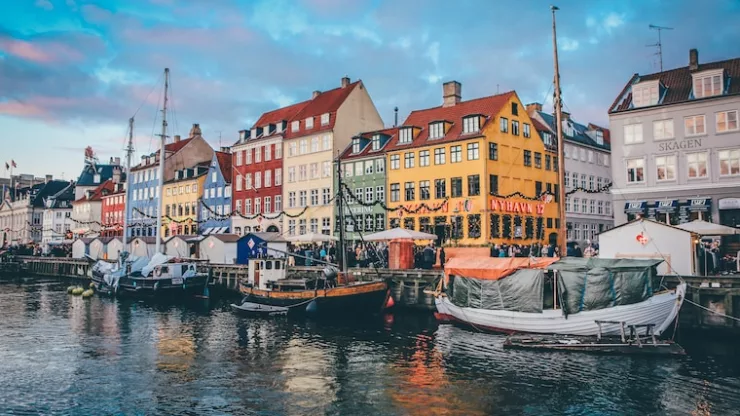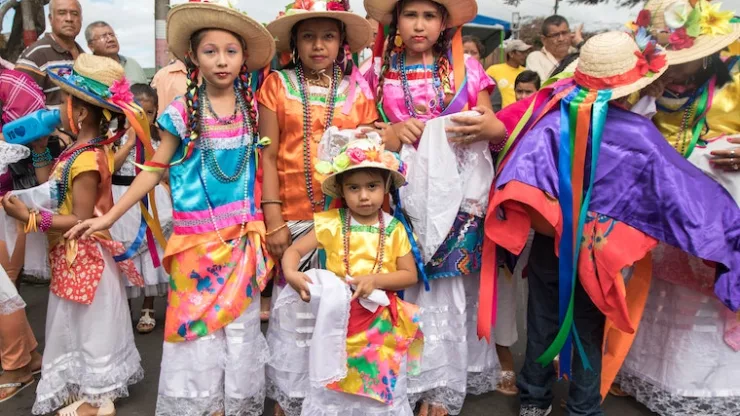Quick Facts
Capital: New Delhi (source)
Population: 1.39 billion (source)
Official Language: Hindi, English (source)
Currency: Indian rupee (source)
National Animal: Bengal tiger (source)
India is a land of diversity and contrasts, known for its vibrant culture, rich heritage, and stunning landmarks.
With a population of over 1.3 billion people, India is a melting pot of religions, languages, and traditions, offering a unique and fascinating glimpse into the heart of South Asia.
Facts About India
- India is the second-most populous country globally, with a population of over 1.3 billion people.
- The country is located in South Asia and shares borders with Pakistan, Nepal, Bhutan, China, Bangladesh, and Myanmar.
- India is the seventh-largest country globally, with an area of 3.3 million square kilometers.
- The country has a diverse landscape, including mountains, plains, plateaus, and islands.
- India’s official languages are Hindi and English, although there are over 1,600 different languages spoken in the country.
- The country has a rich cultural heritage and is famous for its cuisine, music, dance, and festivals.
- India is known for its famous monuments and landmarks, including the Taj Mahal, Qutub Minar, and the Red Fort.
- The country has a federal parliamentary democratic system of government, with the President as the head of state and the Prime Minister as the head of government.
- India’s economy is one of the fastest-growing globally, with a focus on industries such as IT, healthcare, and education.
- The country is home to several major religions, including Hinduism, Islam, Christianity, Sikhism, and Buddhism.
- India is the birthplace of four major religions, including Hinduism, Buddhism, Jainism, and Sikhism.
- The country’s national animal is the Bengal tiger, and its national bird is the peacock.
- India is known for its wildlife, with several national parks and reserves dedicated to protecting endangered species such as the Indian rhinoceros, Asiatic lion, and Bengal tiger.
- The Indian film industry, also known as Bollywood, is the largest in the world, producing over 1,000 films annually.
- The country is also famous for its sports, with cricket being the most popular.
- India has a rich history of science and technology, with several ancient inventions such as the decimal system, yoga, and Ayurveda.
- The country has a tropical climate, with varying temperatures depending on the region.
- India’s education system is one of the largest globally, with over 1 million schools and 36,000 higher education institutions.
- The country’s transportation system is vast, with railways, roads, airports, and ports connecting different parts of the country.
- India’s cuisine is diverse, with regional specialties such as biryani, dosa, and butter chicken.
- The country has several famous rivers, including the Ganges, Brahmaputra, and Yamuna.
- India has a rich tradition of textiles and clothing, with several different types of fabrics and styles.
- The country’s space program is one of the most successful globally, with several achievements such as sending a mission to Mars.
- India’s defense forces are among the largest globally, with over 1.3 million active personnel.
- The Indian flag is made up of three colors- saffron, white, and green, representing courage, peace, and prosperity, respectively. The Ashoka Chakra, a wheel with 24 spokes, is in the center of the flag, representing the cycles of life.
- The country celebrates several national holidays, including Independence Day, Republic Day, and Gandhi Jayanti, which honors the birthday of Mahatma Gandhi.
- India has several world-famous tourist attractions, including the Taj Mahal, one of the Seven Wonders of the World, and the Harmandir Sahib, also known as the Golden Temple.
Conclusion
India is a country with a rich cultural heritage and a diverse landscape.
With a population of over 1.3 billion people, India is the second-most populous country globally and has a federal parliamentary democratic system of government.
The country’s economy is one of the fastest-growing globally, with a focus on industries such as IT, healthcare, and education.
India is also known for its famous landmarks and monuments, such as the Taj Mahal and the Red Fort.
Its cuisine, music, and festivals are famous all over the world, and the country has a rich tradition of science, technology, and spirituality.
Overall, India is a country that offers a unique blend of ancient traditions and modern progress.
FAQ
What is the most popular religion in India?
Hinduism is the most popular religion in India, followed by Islam, Christianity, Sikhism, and Buddhism.
What is the national language of India?
Hindi and English are the official languages of India. However, there are over 1,600 different languages spoken in the country.
What is the currency of India?
The currency of India is the Indian rupee.
What is the most popular sport in India?
Cricket is the most popular sport in India.
What is the literacy rate in India?
According to the latest census, the literacy rate in India is approximately 77%.
What is the climate like in India?
India has a tropical climate, with varying temperatures depending on the region.
The summer months are hot, while the winter months can be chilly in some parts of the country.
What is the history of India’s independence?
India gained independence from British rule on August 15, 1947, after a long struggle led by Mahatma Gandhi and other freedom fighters.
What are some popular Indian dishes?
Some popular Indian dishes include biryani, butter chicken, samosas, dosa, and chaat.
What is the literacy rate in India?
According to the latest census, the literacy rate in India is approximately 77%.
What is the significance of the Bengal tiger in India?
The Bengal tiger is the national animal of India and is a symbol of power, strength, and courage in Indian culture.
What is the Indian Space Research Organization (ISRO)?
The Indian Space Research Organization (ISRO) is the space agency of the Government of India, responsible for India’s space program.
What is the significance of the Ashoka Chakra on the Indian flag?
The Ashoka Chakra, a wheel with 24 spokes, is in the center of the Indian flag and represents the cycles of life.
It is also a symbol of progress, movement, and dynamism.
What are some popular festivals celebrated in India?
India is known for its festivals, which are celebrated with great pomp and show. Some popular festivals include Diwali, Holi, Dussehra, and Eid.
What is the literacy rate in India?
According to the latest census, the literacy rate in India is approximately 77%.
What are some famous landmarks in India?
India is home to several famous landmarks, including the Taj Mahal, Qutub Minar, Red Fort, and the Gateway of India.
What is the education system like in India?
India’s education system is one of the largest globally, with over 1 million schools and 36,000 higher education institutions.
The system includes both private and government-funded schools and universities.
What is the significance of Mahatma Gandhi in India?
Mahatma Gandhi is known as the “Father of the Nation” in India and played a significant role in India’s struggle for independence from British rule.
He is also known for his philosophy of non-violence and his advocacy for civil rights.
What is the economy of India like?
India’s economy is one of the fastest-growing globally, with a focus on industries such as IT, healthcare, and education.
The country has a large and diversified economy, with agriculture, manufacturing, and services sectors contributing significantly to the country’s GDP.
India is also the world’s largest producer of milk, pulses, and spices.
What is the Indian film industry?
The Indian film industry, also known as Bollywood, is the largest in the world, producing over 1,000 films annually.
Bollywood films are known for their colorful song and dance sequences and have a massive following not just in India but also in other parts of the world.
What is the significance of the Ganges river in India?
The Ganges river is considered holy by Hindus, and many people travel to the river to bathe in its waters, which they believe to be purifying.
The river is also an essential source of water for millions of people in India.
What is the significance of the Taj Mahal?
The Taj Mahal is one of the most famous landmarks in India and is known for its intricate marble work and stunning architecture.
It was built by the Mughal Emperor Shah Jahan in memory of his beloved wife Mumtaz Mahal and is considered a symbol of love and devotion.
What is the Indian railway system like?
The Indian railway system is one of the largest in the world, with over 67,000 kilometers of track and over 7,000 stations.
The system connects different parts of the country and is an essential mode of transportation for millions of people in India.
What is the significance of yoga in India?
Yoga is an ancient practice that originated in India and is known for its physical, mental, and spiritual benefits.
It is now practiced all over the world and is considered a form of exercise and meditation.
What is the significance of the peacock in India?
The peacock is the national bird of India and is a symbol of grace, beauty, and pride.
It is also associated with Lord Krishna, who is often depicted wearing a peacock feather in his hair.
What is the significance of the lotus flower in India?
The lotus flower is considered a sacred symbol in India and is associated with many Hindu gods and goddesses.
It is a symbol of purity, enlightenment, and spiritual awakening.
What is the significance of the Red Fort?
The Red Fort is a historic landmark in Delhi and was the main residence of the Mughal emperors for over 200 years.
It is known for its stunning architecture and is now a UNESCO World Heritage Site.
What is the significance of the Qutub Minar?
The Qutub Minar is a minaret in Delhi and is one of the tallest brick minarets in the world.
It was built in the 12th century and is now a UNESCO World Heritage Site.

I am a fun fact enthusiast and creator of Facts On Tap.
I love to share my knowledge and curiosity with readers and inspire them to learn something new every day.
When I’m not writing, I enjoy traveling, reading, and playing trivia games with my friends.





